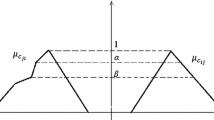Abstract
In this paper, at first, we provide some results on the group of vectors with components in a divisible Abelian linearly ordered group, the related subgroup of \(\odot\)-normal vectors, the relation of \(\odot\)-proportionality and the corresponding quotient group. Then, we apply the achieved results to the groups of reciprocal and consistent matrices over divisible Abelian linearly ordered groups; this allows us to deal with the problem of deriving a weighting ranking for the alternatives from a pairwise comparison matrix. The proposed weighting vector has several advantages; it satisfies, for instance, the independence of scale-inversion condition.
Similar content being viewed by others
References
Barzilai J (1997) Deriving weights from pairwise comparison matrices. J Oper Res Soc 48:1226–1232
Barzilai J (1998) Consistency measures for pairwise comparison matrices. J MultiCrit Decis Anal 7:123–132
Basile L, D’Apuzzo L (1997) Ranking and weak consistency in the a.h.p. context. Rivista di matematica per le scienze economiche e sociali 20(1):99–110
Basile L, D’Apuzzo L (2002) Weak consistency and quasi-linear means imply the actual ranking. Int J Uncertain Fuzziness Knowl Based Syst 10(3):227–239
Basile L, D’Apuzzo L (2006a) Transitive matrices, strict preference and intensity operators. Math Methods Econ Finance 1:21–36
Basile L, D’Apuzzo L (2006b) Transitive matrices, strict preference and ordinal evaluation operators. Soft Comput 10(10):933–940
Birkhoff G (1984) Lattice theory, vol 25. American Mathematical Society, RI
Cavallo B, D’Apuzzo L (2009a) A general unified framework for pairwise comparison matrices in multicriterial methods. Int J Intell Syst 24(4):377–398
Cavallo B, D’Apuzzo L (2009b) Recent advances in applied mathematics, chapter Transitive pairwise comparison matrices over abelian linearly ordered groups, pp 207–212. WSEAS
Cavallo B, D’Apuzzo L (2010) Characterizations of consistent pairwise comparison matrices over abelian linearly ordered groups. Int J Intell Syst 25(10):1035–1059
Cavallo B, D’Apuzzo L, Squillante M (2009) Building consistent pairwise comparison matrices over abelian linearly ordered groups. In: Algorithmic decision theory, Lecture notes in artificial intelligence, vol 5783, Springer, Berlin, pp 237–248
Cavallo B, D’Apuzzo L, Squillante M (2011) About a consistency index for pairwise comparison matrices over a divisible alo-group. Int J Intell Syst (Submitted)
D’Apuzzo L, Marcarelli G, Squillante M (2007) Generalized consistency and intensity vectors for comparison matrices. Int J Intell Syst 22(12):1287–1300
Fucks L (1960) Abelian groups. Pergman Press, New York
Herrera-Viedma E, Herrera F, Chiclana F, Luque M (2004) Some issue on consistency of fuzzy preferences relations. Eur J Oper Res Soc 154:98–109
Saaty TL (1977) A scaling method for priorities in hierarchical structures. J Math Psychol 15:234–281
Saaty TL (1980) The analytic hierarchy process. McGraw-Hill, New York
Saaty TL (1986) Axiomatic foundation of the analytic hierarchy process. Manag Sci 32(7):841–855
Saaty TL (1990) Eigenvector and logarithmic least squares. Eur J Oper Res Soc 48(1):156–160
Author information
Authors and Affiliations
Corresponding author
Appendix
Appendix
In this section, we provide examples for deriving a weighting vector from a PCM (Examples 1, 2, 3) and for showing how our approach is able to deal with the independence of the scale-inversion condition (Example 4).
Example 1
Let \(\{x_{1},x_{2},x_{3},x_{4}\}\) be a set of alternatives and
a multiplicative PCM encoding the preference intensities of the alternatives. \(A\) is a consistent PCM because the columns are proportional with respect to the multiplication \(\cdot\) (see Proposition 30): \(\underline {a}^{k}=a_{1k}\cdot\underline {a}^{1},\) for \(k = 2,3, 4.\) By Proposition 36, each column is an ordinal evaluation vector; thus the actual ranking is \(x_{1} \succ x_{2} \succ x_{3} \succ x_{4}.\) The vector
is the weighting vector; it is a \(\odot\)-normal vector, in fact \(\prod_{i=1}^{4}m_{\cdot}( \underline {a}_{i})=1.\)
We stress that \(\underline {w}_{m_{\cdot}}(A)\) can be obtained by applying the \(\odot\)-normalization function \(N\) to an arbitrary column, for instance by choosing \(\underline {a}^{1}, \) we have:
Example 2
Let \(\{x_{1},x_{2},x_{3},x_{4}\}\) be a set of alternatives and
an additive PCM encoding the preference intensities of the alternatives. \(B\) is a consistent PCM because the columns are proportional with respect to the addition \(+\) (see Proposition 30): \(\underline {b}^{k}=b_{1k}+\underline {b}^{1},\) for \(k = 2,3, 4.\) By Proposition 36, each column is an ordinal evaluation vector; thus the actual ranking is \(x_{3} \sim x_{4} \succ x_{2} \succ x_{1}.\) The vector
is the weighting vector; it is a \(\odot\)-normal vector, in fact \(\sum_{i=1}^{4}m_{+}( \underline {b}_{i})=0.\)
We stress that \(\underline {w}_{m_{+}}(B)\) can be obtained by applying the \(\odot\)-normalization function \(N\) to an arbitrary column, for instance by choosing \(\underline {b}^{1},\) we have:
Example 3
Let \(\{x_{1},x_{2},x_{3},x_{4}\}\) be a set of alternatives and
a fuzzy PCM encoding the preference intensities of the alternatives. \(C\) is a consistent PCM because the columns are \(\otimes\)-proportional (see Proposition 30): \(\underline {c}^{k}=c_{1k}\otimes \underline {c}^{1},\) for \(k = 2,3, 4.\) By Proposition 36, each column is an ordinal evaluation vector; thus the actual ranking is \(x_{1} \succ x_{2} \succ x_{3} \succ x_{4}.\) Moreover, by applying (8), we obtain the weighting vector:
\(\underline {w}_{m_{\otimes}}(C)\) is a \(\otimes\)-normal vector, in fact, by applying (7), \(\bigotimes_{i=1}^{4}m_{\otimes}( \underline {c}_{i})=0.5.\)
We stress that \(\underline {w}_{m_{\otimes}}(C)\) can be obtained by applying the \(\odot\)-normalization function \(N\) to an arbitrary column, for instance by choosing \(\underline {c}^{1}, \) we have:
Example 4
Let \(\{x_{1},x_{2},x_{3},x_{4}\}\) be a set of alternatives and
a multiplicative PCM encoding the preference intensities of the alternatives. As \(d_{14}\neq d_{13}d_{34}, D\) is an inconsistent PCM and, by \(\odot\)-reciprocity, \(D^{(-1)}=\frac{1}{D}\) is inconsistent too. The principal eigenvalue of \(D\) and \(\frac{1}{D}=D^{T}\) is \(\lambda_{\rm max}=4.18552\) and the corresponding eigenvectors are
The eigenvectors \(\underline {w}_{\lambda_{\rm max}}(D)\) and \(\underline {w}_{\lambda_{\rm max}}(\frac{1}{D})\) provide different rankings, that are:
respectively. Differently, the geometric mean vectors associated to \(D\) and \(\frac{1}{D},\)
provide the same ranking:
We stress that, the preference ratios, expressed by means of \(D\) (or equivalently \(\frac{1}{D}\)), agree with ranking (43); indeed, \(x_{4}\sim x_{2}\) according to \(d_{24}=d_{42}=1, x_{2} \succ x_{3}\) according to \(d_{23}>1, x_{3} \succ x_{1}\) according to \(d_{31}>1\) and \(x_{4} \succ x_{1}\) according to \(d_{41}>1.\)
Rights and permissions
About this article
Cite this article
Cavallo, B., D’Apuzzo, L. Deriving weights from a pairwise comparison matrix over an alo-group. Soft Comput 16, 353–366 (2012). https://doi.org/10.1007/s00500-011-0746-8
Published:
Issue Date:
DOI: https://doi.org/10.1007/s00500-011-0746-8




